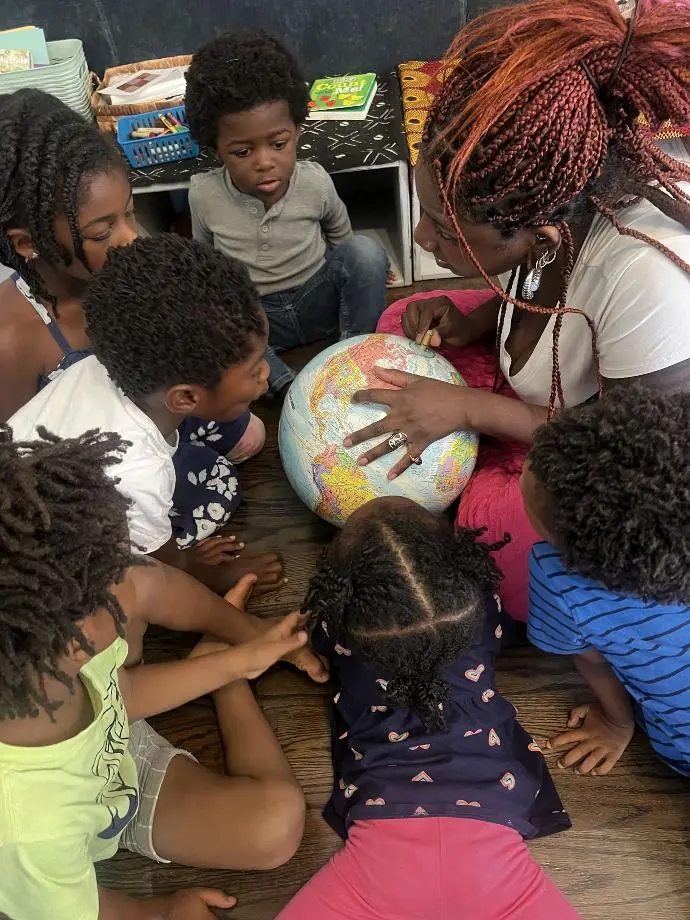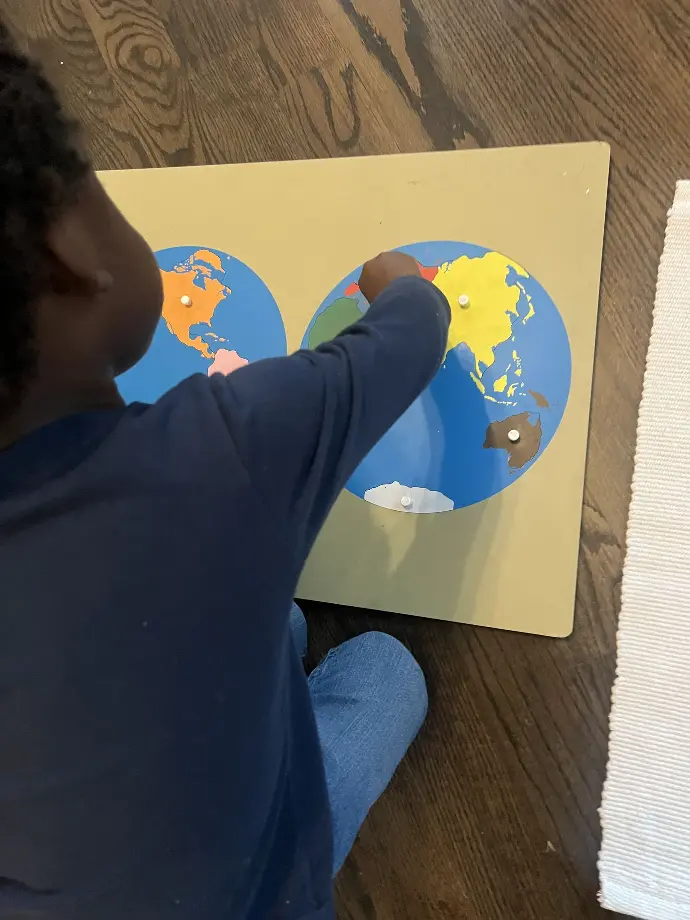ID: An extended arm wearing a black sweater is hanging up a circular world map in front of a beige background.
As educators and administrators, we often find our plates overflowing with "to-do' lists" and attending to rules, mandates, and expectations from our schools and state governments. In this whirlwind of responsibilities, topics like diversity can unintentionally fade into the background. I hope this article inspires you to wonder and co-create a learning environment that provides children with roots to become grounded in their culture and identity and wings to explore other cultures and identities.

Global Diversity Awareness Month
"This observance encourages us to recognize the value of diversity in all aspects of life"- Ashley Causey-Golden
ID: Sitting on the ground, a Black teacher is pointing to a globe in front of her while six young Black young students around her are looking at the globe.
Global Diversity Awareness Month, observed annually in October, serves as a dedicated time to celebrate the rich tapestry of cultures, ethnicities, and experiences that make up our global community. This observance encourages us all to recognize and appreciate the value of diversity in all aspects of life. As an educator I want to highlight the value of diversity in school and other educational settings. While this may seem like an "of course" moment, it requires intentional planning when it comes to curating books, creating lessons, and finding primary and secondary resources to aid in teaching about diverse cultures worldwide.
From WWII to Today
The concept of a month dedicated to diversity awareness emerged after World War II from the United Nations General Assembly. The adoption of the Universal Declaration of Human Rights in Paris laid the foundation for a grassroots movement to promote and spread the importance of committing to diversity and inclusion work. While pinpointing the exact start of the movement is challenging, its impact is evident in the changing laws, policies, and hiring decisions over the decades, moving towards more diverse and global representation.
The Importance for Educators
As a teacher, making diversity an important aspect of your classroom helps all students feel valued and represented. This is an intentional act to create space for conversations to counteract the stereotypes and discrimination that is everywhere. This work is necessary as we prepare our students for a global world. The likelihood of our students attending college or working with peer that hold different cultural, religious, ethnic, identity than their own is rapidly increasing. The focus is not about being “nice and kind” to those who have a different cultural background or racial identity. It is about expanding one’s view to understand that multiple perspectives can exist at the same time. One way of seeing or acknowledging the world is not “better” or “more right” than another. Weaving in diversity into your lessons enhances critical thinking because children are listening to and exploring different viewpoints. For children this provides opportunity to make comparisons to their beliefs, see the differences and when properly prepared, it can provide the environment for children to challenge assumptions.
The Importance for Global Majority
While diversity education benefits all students, it holds particular significance for students of the global majority (students who are non-white) because of the power of representation. When children are able to see themselves within the curriculum, it provides the opportunity for those students to become rooted or invested within the lessons, leading to strengthened identities and more positive self-worth within their learning environment. These children will also tend to become more engaged academically with the lesson. We can’t ignore how diverse representation allows all students to develop wings to expand their ability to understand and become inclusive as they challenge the negative stereotypes of “I thought all ______ did this or ate that” and build their mental library of diverse narratives. This helps add complexity and depth to a child’s understand of their culture and others cultures.
Montessori-Inspired Lessons for Children 3-12
As a Montessorian, and founder of the company Afrocentric Montessori, I see that Montessori education, with its emphasis on hands-on learning and cultural understanding, offers excellent opportunities to celebrate diversity. I mentor new Montessori teachers providing support, perspective, and metacognitive prompts. I also help teachers brainstorm activites best suited to their classroom. Here are some examples of age-appropriate activities.

Diversity by design
Making innovative design requires us to push the limits of technological possibilities. As a group of in-house educators specializing in mentorship, we develop and implement curricula that works. Through a mixture of project-based work and research, we make unforgettable tools that keep pace with today's classrooms.
ID: A young black child is kneeling on a hardwood floor wearing jeans and a navy shirt, putting a white pin on a circular world map.
Montessori-Inspired Lessons for Children
ages 3-6 years
For children aged 3-6, you can start you morning circle or meeting with greetings in different languages. If you have children from that culture, ask them to share how they might greet their parents and loved ones in the morning. You can be the catalyst to provide the wings for your students to learn about the different cultures around the world. I encourage teachers to have a globe or world map handy during your morning circle time. This can be used to show the children where the language they are speaking is used. This also adds a layer of geography that deepens the interaction.
Ages 6-9 years
For children aged 6-9, you can explore global folktales and have children compare and contrast narratives from around the world. Another activity I suggest is having students talk to their loved ones about what they consider home. It does not have to be immediate family, but someone that the child considers family. The intention is for children to learn about their loved ones’ history, where they are from, and where is home for them. This can expand into a language, art, and geography project.
Ages 9-12 years
In this middle school age group you can focus on a larger project that involves researching and presenting. An activity involving students' research centering different cultures’ contributions to the science and art world is a good place to start. This will provide children with the necessary exposure to expand beyond the boiler plate curricula centering white male researchers and artists, like Benjamin Franklin .
By integrating these activities throughout the year, educators can use Global Diversity Awareness Month as a springboard for ongoing conversations and learning about diversity. This approach not only enriches the educational experience but also nurtures empathy, cultural competence, and global citizenship in students of all backgrounds.
In conclusion, Global Diversity Awareness Month offers a valuable opportunity for educators to create more inclusive, understanding, and globally minded classrooms. By embracing diversity and incorporating it into the curriculum, we can help shape a generation of students who are better equipped to navigate and contribute positively to our diverse world. Let's commit to providing our students with both roots and wings, grounding them in their own identities while empowering them to explore and appreciate the rich diversity of our global community.